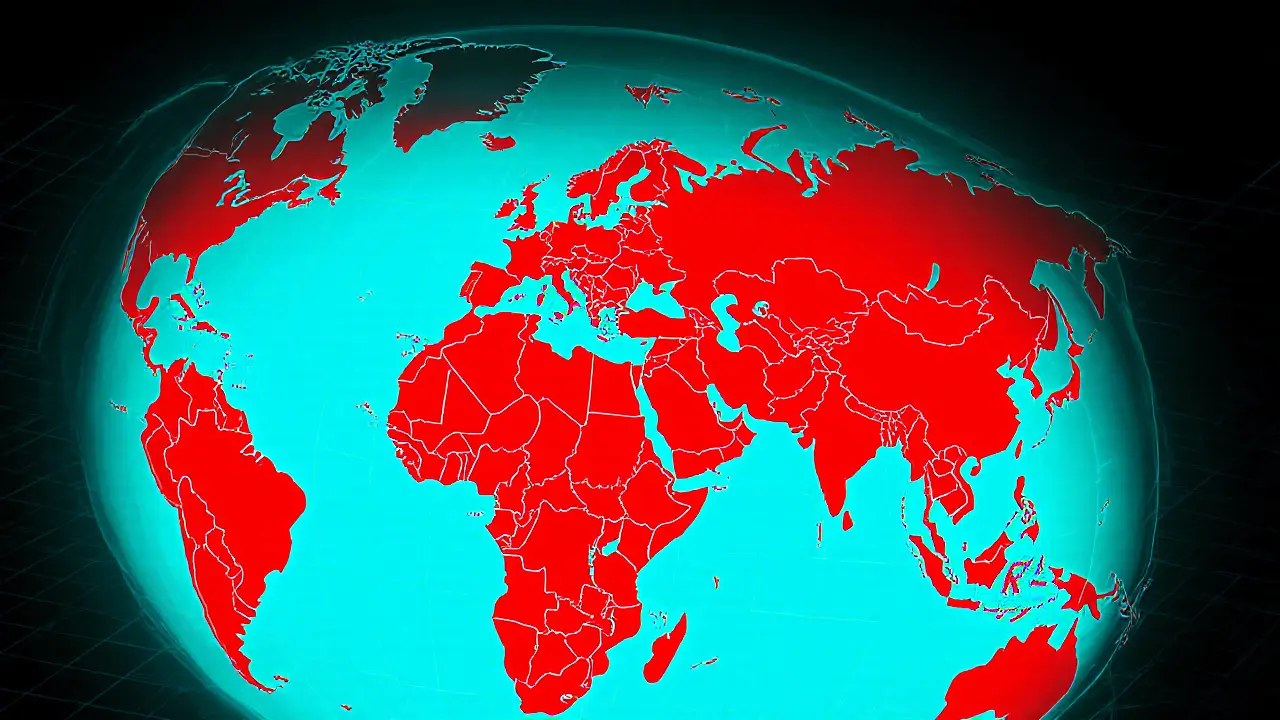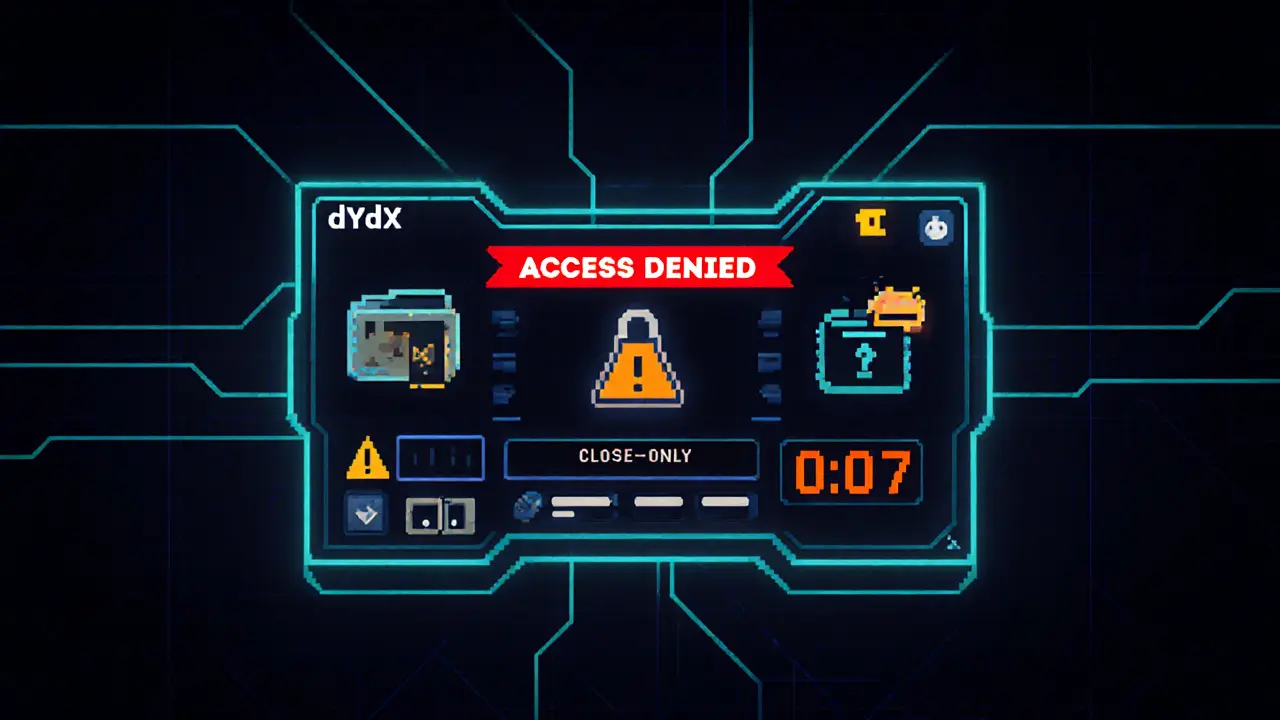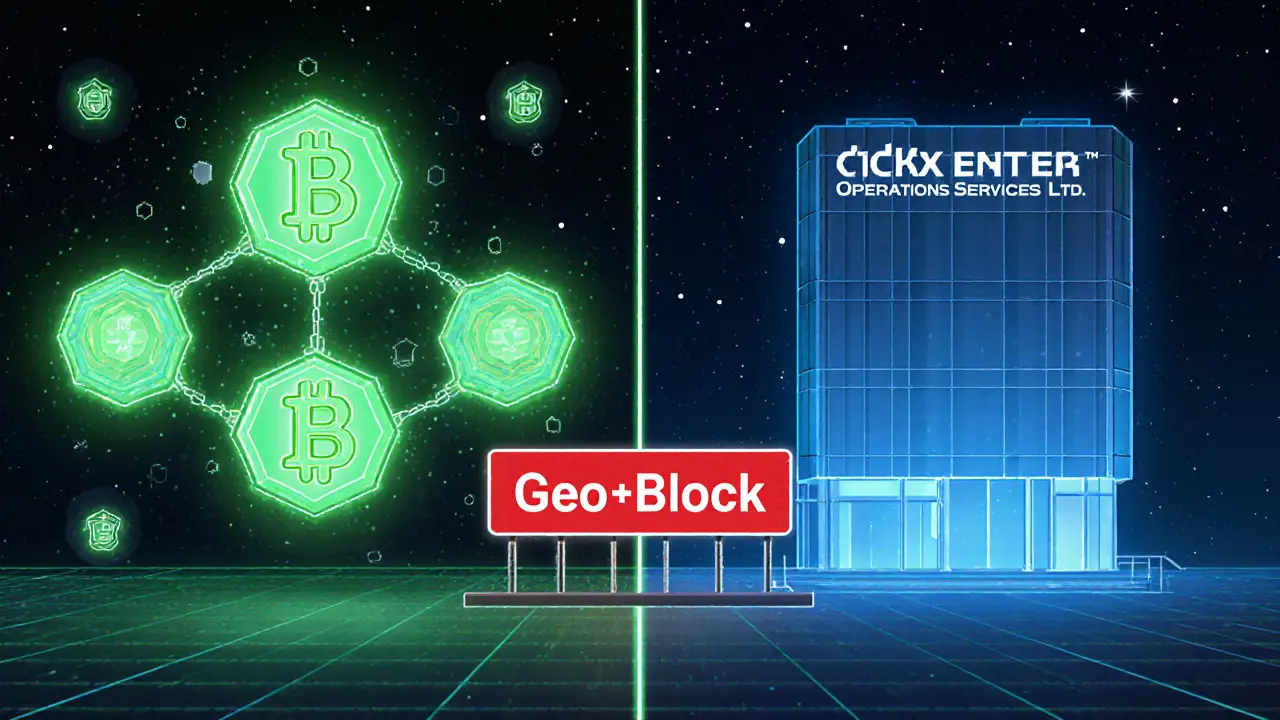Posted By Tristan Valehart On 7 May 2025 Comments (19)

dYdX Country Access Checker
Check Your Country Access
Enter your country or region to see if you're currently allowed to trade on dYdX.
Currently Restricted Jurisdictions
| Region | Restricted Countries / Territories |
|---|---|
| North America | United States, Canada |
| Europe | United Kingdom, Crimea, Donetsk, Luhansk |
| Middle East & North Africa | Iran, Iraq, Libya, Sudan, Yemen |
| Africa | Congo (DRC), Mali, Somalia, Zimbabwe |
| Asia | North Korea, Syria, Myanmar (Burma) |
| Caribbean & Central America | Cuba, Nicaragua |
Note: This list reflects restrictions as of October 2025. Restrictions may change due to new sanctions or legal updates.
When you hear about dYdX is a crypto‑derivatives platform that markets itself as a decentralized exchange, the first question is whether you can trade from anywhere in the world. The short answer: no. The platform enforces a long list of blocked regions even though its core trading engine lives on‑chain. Below you’ll find the real reason behind those blocks, the full list of restricted territories, and what happens to a wallet that trips the compliance filter.
Key Takeaways
- dYdX limits access for users in the U.S., U.K., Canada and over 30 other jurisdictions.
- Restrictions are enforced by dYdX Operations Services Ltd. through front‑end geo‑blocking and a “close‑only” mode.
- Even though trade settlement is on‑chain, the centralized front‑end lets regulators shut you out.
- If you are placed in close‑only mode for seven days, your wallet becomes fully dYdX country restrictions blocked.
- Always check the latest terms-restricted lists can change with new sanctions.
How dYdX Promises Decentralization
The platform was founded in 2017 by Antonio Juliano is a Princeton CS graduate and former Coinbase engineer. Juliano’s vision was a trust‑less protocol where anyone could open perpetual swaps without a middle‑man. Under the hood, dYdX uses smart contracts on Ethereum, Layer‑2 solutions and the DYDX token (the native utility token) to settle trades, settle funding rates and distribute governance power.
In theory, that architecture means anyone with a compatible wallet can trade, regardless of geography. In practice, the user experience is mediated by a web front‑end (dydx.trade) that lives on a corporate stack.
The Centralized Layer That Enforces Borders
All front‑end requests pass through dYdX Operations Services Ltd. (DOS), a subsidiary that runs the UI, APIs and KYC/AML screening. DOS can read a user’s IP address, tap into geo‑IP databases, and flag wallets that originate from restricted zones.
When a flag is raised, the platform instantly flips the wallet into “close‑only mode”. While in this mode you can:
- Cancel existing orders.
- Reduce or fully close open positions via reduce‑only orders.
- Withdraw funds that are already on‑chain.
- Deposit new collateral.
- Open fresh positions.
- Transfer assets between sub‑accounts.
Why the Platform Needs to Block Countries
The restrictions are not a technical limitation; they are a compliance decision. dYdX must obey:
- The U.S. Department of the Treasury sanctions programs (including OFAC).
- The Office of Foreign Assets Control (OFAC) list of prohibited persons and entities.
- Anti‑Money‑Laundering (AML) and Counter‑Terrorism Financing (CTF) rules that apply to any entity with a U.S. presence.
Because dYdX Trading Inc. is incorporated in New York and the dYdX Foundation operates out of Zug, Switzerland, the platform is subject to both U.S. and EU regulatory regimes. Ignoring a sanction could expose the company to hefty fines, asset freezes, or even criminal prosecution.

Full List of Restricted Jurisdictions (as of Oct2025)
| Region | Specific Countries / Territories |
|---|---|
| North America | United States, Canada |
| Europe | United Kingdom, Crimea, Donetsk, Luhansk |
| Middle East & North Africa | Iran, Iraq, Libya, Sudan, Yemen |
| Africa | Congo (DRC), Mali, Somalia, Zimbabwe |
| Asia | North Korea, Syria, Myanmar (Burma) |
| Caribbean & Central America | Cuba, Nicaragua |
The list is not static; new sanctions or changes in local law can add or remove entries. dYdX updates its Terms of Service quarterly.
Countries That Remain Accessible - A Curious Exception
Surprisingly, dYdX still allows users from China, Russia, South Korea, Japan and Vietnam. Those markets are not on any U.S. sanctions list, so the platform can legally keep them open while still blocking the countries above. This “selective compliance” shows the company is following the letter of the law rather than a blanket risk‑averse policy.
Practical Checklist for Prospective Traders
- Confirm your residency is not on the restricted list before signing up.
- Use a VPN only for privacy; it will *not* bypass DOS geo‑blocking and may trigger compliance alerts.
- Keep your wallet’s secret recovery phrase safe - it’s the only way out if you ever get blocked.
- Monitor dYdX’s Terms of Service page for updates; changes can happen with as little as 30‑day notice.
- If you are placed in close‑only mode, liquidate positions quickly to avoid forced closures.
What Happens If You’re Blocked
Once a wallet reaches the “Blocked” status, the UI stops working. The only remaining function is the export of the Secret Recovery Phrase (SRP). With the SRP you can import the wallet into any other DeFi app, withdraw assets from the chain directly, or move them to a hardware wallet. Remember, the on‑chain positions are still yours; only the dYdX front‑end refuses to forward new transaction requests.
Because the underlying smart contracts are open source, a technically savvy user could interact with them via a tool like Etherscan or a custom script. However, that requires building and signing raw transactions, a step most retail traders are unwilling to take.
Future Outlook - Will dYdX Go Fully Decentralized?
There is ongoing community debate. The dYdX Foundation (the Swiss entity that issued the DYDX token) has pledged to migrate more governance to token holders. If the front‑end becomes truly permissionless, the geographic bans would evaporate. Until then, the hybrid model-on‑chain core + corporate UI-will keep the platform tethered to traditional regulation.
For now, the safest bet is to treat dYdX as a regulated service that offers decentralized execution, not as a purely permissionless protocol.

Frequently Asked Questions
Can I use a VPN to access dYdX from a restricted country?
No. dYdX checks the IP address at the front‑end level and flags the wallet regardless of VPN use. Using a VPN may actually trigger the compliance alert faster.
Is the “close‑only mode” reversible?
If you move out of the restricted jurisdiction (e.g., travel to an allowed country) and the IP check no longer flags you, the wallet can return to normal trading after a manual review. Otherwise, the status stays until the seven‑day block converts it to “Blocked”.
What assets can I withdraw after being blocked?
All on‑chain assets you hold (DYDX, ETH, BTC, etc.) are still yours. You can export the SRP, import the wallet into another DeFi app, and withdraw via a direct contract call.
Why does dYdX allow users from China but not the United States?
U.S. sanctions and AML rules specifically target U.S. persons and many of the listed countries. China is not on the OFAC sanction list, so the platform can legally serve Chinese residents while still complying with U.S. law.
Will dYdX’s restrictions change if the U.S. lifts sanctions on a country?
Yes. The restricted list is tied to official sanction regimes. When a country is removed from OFAC’s list, dYdX typically updates its Terms within a month to reflect the new status.


Darius Needham
May 7, 2025 AT 12:20The geo‑blocking you see on dYdX is not a bug in the smart contracts; it’s a deliberate compliance layer built into the front‑end. Because dYdX Operations Services Ltd. controls the API gateway, it can read your IP address and cross‑reference it with sanction lists. When a match occurs the wallet is instantly switched to “close‑only” mode, preventing new collateral deposits. This mechanism satisfies both U.S. OFAC requirements and EU AML directives without altering the on‑chain logic. In practice it means the protocol remains decentralized, but the user experience is still governed by corporate policy.
karyn brown
May 11, 2025 AT 04:20Yo, this whole “decentralized” hype is kinda sus, ya know? 😅 The list of blocked zones looks like a copy‑paste from a government blacklist, and that’s totally legit 😂 but also a bummer for folks in those regions. The UI just bounces you out, no magic trick to bypass it, even if you spin up a VPN. Honestly, it feels like they’re playing both sides – claiming liberty while hand‑cuffing users. Definately a mixed message. 🤷♀️
Megan King
May 14, 2025 AT 20:20Hey fam, just wanted to drop a quick note that even though the front‑end blocks certain countries, your assets are still yours on‑chain. If you ever get slammed into close‑only mode, just remember to pull your funds out ASAP. It’s kinda like a safety net – not perfect, but better than losing everything. Keep an eye on the terms page ’cause they tweak the list often. Stay chill and trade smart!
Rachel Kasdin
May 18, 2025 AT 12:20As an American, it’s crystal clear why the U.S. sits at the top of dYdX’s blocked list – the company can’t afford a federal lawsuit. They’re playing it safe, but it also feels like a slap in the face for users who value true decentralization. The whole “we’re a permissionless protocol” line rings hollow when a New York‑based subsidiary can just shut you out. It’s a reminder that jurisdiction still matters, no matter how many layers you add.
karsten wall
May 22, 2025 AT 04:20From a systemic architecture perspective, the dichotomy between on‑chain execution and off‑chain access control constitutes a classic hybrid model. The enforcement of geo‑blocking via DOS introduces a point of centralization that can be quantified through latency metrics and compliance cost functions. Consequently, the protocol’s trustlessness is bounded by the opacity of the API gateway’s decision matrix. This raises interesting questions about the elasticity of decentralization under regulatory pressure.
Keith Cotterill
May 25, 2025 AT 20:20Indeed, the ostensible paradox of dYdX’s operational paradigm, wherein a decentralized ledger coexists with a centralized compliance veneer, underscores a profound ontological tension, one that, arguably, reflects the broader zeitgeist of contemporary blockchain governance; the juxtaposition of immutable code and mutable policy, immutable code, yet mutable policy! Moreover, the preponderance of legal mandates, the inexorable march of sanctions, the inexorable march of sanctions-these factors inexorably compel the platform’s custodians to enact draconian geo‑filters.
Noel Lees
May 29, 2025 AT 12:20Wow, that’s some serious tech juggling! 😎 The fact that you can still withdraw on‑chain assets even when the UI says “blocked” is a huge relief. It shows the engineers built a safety net, which is pretty awesome for us optimistic traders. Just make sure to have that secret recovery phrase handy, because once you’re in close‑only mode you’ll need it to escape. Keep the good vibes rolling! 😊
Adeoye Emmanuel
June 2, 2025 AT 04:20In the grand theatre of decentralized finance, the curtain may fall on the front‑end, but the actors – your tokens – remain steadfast upon the immutable stage of Ethereum. When the platform imposes a “close‑only” regime, it merely scripts a temporary pause, not an annihilation of ownership. Thus, the dramatic tension lies not in loss of assets but in the choreography between compliance and sovereignty. By safeguarding the recovery phrase, you retain the agency to rewrite the final act whenever the regulatory winds shift.
Kamva Ndamase
June 5, 2025 AT 20:20Listen up, y’all! This whole “we’re open for everyone except the ones we don’t like” vibe is straight up aggressive, but it’s the reality of how these platforms dance around sanctions. They’re throwing out a rainbow of “allowed” countries while shut‑ing the door on others – it’s like a selective party invite. If you’re from one of the blocked spots, you gotta hustle and move your crypto elsewhere, pronto! No mercy, no compromise.
bhavin thakkar
June 9, 2025 AT 12:20Let’s unpack the mechanics here: dYdX’s smart contracts execute trades on a Layer‑2 solution, which is truly permissionless. However, the user interface, API endpoints, and KYC/AML layers are governed by corporate policy. The “close‑only” mode is triggered by a flag set in the backend, which references OFAC sanction lists. This bifurcation creates a functional separation: on‑chain logic remains immutable, while off‑chain access is mutable. Consequently, users in restricted jurisdictions retain on‑chain ownership but lose convenient UI interaction, a nuance often overlooked in casual discussions.
Thiago Rafael
June 13, 2025 AT 04:20It is imperative to recognize that the contractual obligations of dYdX Trading Inc., incorporated under New York law, render it susceptible to United States jurisdictional mandates. Accordingly, the enforcement of geo‑blocking measures constitutes a legally defensible action, albeit one that may appear incongruous with the platform’s ostensible decentralization ethos. The operational necessity of compliance underscores the inherent tension between regulatory adherence and the philosophic ideal of an unbounded financial ecosystem.
Marie Salcedo
June 16, 2025 AT 20:20Hey there! If you’re worried about getting blocked, just double‑check the country list before you sign up. It’s super easy to miss, but staying informed can save you a lot of hassle. And remember, your crypto stays yours even if the UI says otherwise – you can always pull it out with your seed phrase. Keep it simple and stay safe!
dennis shiner
June 20, 2025 AT 12:20Sure, because a “close‑only” mode totally solves everything. 🙄
Mangal Chauhan
June 24, 2025 AT 04:20It is with considerable respect for the regulatory environment that I must advise all prospective traders to consult the official dYdX jurisdictional matrix prior to engagement. Compliance with OFAC directives and EU AML statutes is not merely advisable but obligatory for the preservation of operational continuity. 😊
WILMAR MURIEL
June 27, 2025 AT 20:20Let me take a moment to reflect on the broader implications of dYdX’s hybrid architecture, for those of us who have been following the evolution of decentralized exchanges with a keen eye. The platform’s core, built on Ethereum Layer‑2, undeniably offers a level of trustlessness that is commendable; however, the overlay of a corporate front‑end reintroduces a point of centralization that cannot be ignored. When a user’s IP address is matched against sanctioned lists, the system flags the wallet and imposes a “close‑only” mode, effectively stripping the user of the ability to open new positions while still allowing withdrawals. This action, while legally prudent, creates a paradoxical user experience: one moment you are fully empowered by a decentralized protocol, the next you are subject to the whims of a compliance team located in New York and Zug. Moreover, the seven‑day period before a wallet is escalated to “Blocked” status adds a temporal dimension to the penalty, incentivizing rapid liquidation of positions-a process that may introduce additional market volatility. The fact that the underlying smart contracts remain accessible means that determined users can, in theory, craft bespoke transaction scripts to bypass the UI, but such an approach demands a technical sophistication that most retail traders simply do not possess. Consequently, the practical effect is that the majority of users remain bound by the front‑end’s restrictions, effectively turning the protocol into a permissioned service under the guise of decentralization. As the regulatory landscape continues to evolve, we may see dYdX either fully embrace a permissionless model, shedding its corporate veneer, or double down on compliance, further cementing its hybrid status. In either scenario, the on‑chain assets remain under the sole ownership of the user, a reassuring constant amidst a sea of shifting policies. Ultimately, the onus is on traders to stay informed, keep their recovery phrases secure, and understand that the “decentralized” label does not guarantee unfettered access across all jurisdictions.
jit salcedo
July 1, 2025 AT 12:20Honestly, this whole geo‑blocking drama feels like the elite trying to keep the masses in check, like some covert cabal pulling strings behind the curtain. They’ll tell you it’s “compliance,” but really it’s about power dynamics and who gets to trade. It’s a lazy excuse for a system that can’t handle true freedom.
Joyce Welu Johnson
July 5, 2025 AT 04:20I hear you, and I want to emphasize that while the restrictions can be frustrating, your assets remain safe on‑chain. The best approach is to keep your secret recovery phrase stored securely and consider using a hardware wallet for added protection. If you ever find yourself in “close‑only” mode, act quickly to withdraw or move your funds to avoid any unnecessary complications.
Ally Woods
July 8, 2025 AT 20:20This is absurd.
Kristen Rws
July 12, 2025 AT 12:20Keep your head up and don’t let the block stop you from trading when you can – you got this! 😊